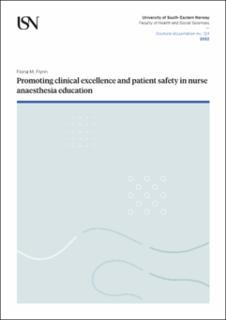| dc.contributor.author | Flynn, Fiona M. | |
| dc.date.accessioned | 2022-06-09T11:56:24Z | |
| dc.date.available | 2022-06-09T11:56:24Z | |
| dc.date.issued | 2022 | |
| dc.identifier.isbn | 978-82-7206-660-3 | |
| dc.identifier.issn | 2535-5252 | |
| dc.identifier.uri | https://hdl.handle.net/11250/2998141 | |
| dc.description.abstract | Background: There has been increasing international focus over the past couple of decades, on the importance of non-technical skills such as situation awareness, decision-making, task management and teamwork in developing clinical excellence and ensuring patient safety in anaesthesia. However, non-technical skills are currently not systematically integrated in nurse anaesthesia education and there is a need for standardized and reliable instruments for developing and assessing these skills. The structured behavioural assessment instrument Nurse Anaesthetists’ Non-Technical Skills-Norway (NANTS-no) was adapted for nurse anaesthetists in Norway and may be appropriate for this use.
Aim: The primary aim of this research is the systematic development and assessment of non-technical skills using a validated structured behavioural assessment instrument, as a means of promoting clinical excellence and patient safety in nurse anaesthesia education. The following objectives were identified: • To evaluate the psychometric properties of NANTS-no (Study I)
• To explore how NANTS-no enables a systematic development and assessment of student nurse anaesthetists’ non-technical skills in clinical practice (Study II)
• To explore the experiences of using NANTS-no in clinical practice during nurse anaesthesia education (Study III)
Theoretical perspectives: This research is positioned within a pragmatist research paradigm.
Methods: A sequential multimethod design was chosen where the findings in each study influenced the design of the following one. The first two studies used quantitative methods while the third study had a qualitative approach. The research was carried out between October 2017 and September 2020. Participants were student nurse anaesthetists attending the master’s program in nurse anaesthesia at a Norwegian university, and their mentors and clinical supervisors at the various hospitals where they had clinical practice.
Study I had an explorative design. 46 nurse anaesthetists involved in clinical supervision attended a 6-hour workshop on non-technical skills. Afterwards they rated non-technical skills displayed by nurse anaesthetists in video-recorded simulated scenarios and completed a questionnaire. The instrument’s psychometric properties were evaluated using generalizability and classical test theory.
Study II was a cohort study with longitudinal design. 20 student nurse anaesthetists’ non-technical skills were assessed at three time-points during their nurse anaesthesia education. The NANTS-no five-point rating scale was used by the students, their mentors and clinical supervisors to perform the assessments, and the data was analyzed using linear mixed effect models.
Study III had a descriptive design. The experiences of using NANTS-no in clinical practice were collected through semi-structured interviews with four focus groups comprising 12 student nurse anaesthetists and 13 mentors and clinical supervisors. Data was analyzed using qualitive content analysis.
Results: NANTS-no demonstrated high reliability and dependability in a controlled setting and was regarded as a useful instrument for use in clinical supervision. It also demonstrated reliability when assessing non-technical skills in clinical practice. The student nurse anaesthetists demonstrated a systematic development of non-technical skills during nurse anaesthesia education, achieving near excellence when assessed with NANTS-no. Using NANTS-no was described in the interviews as a means of promoting excellent non-technical skills and cooperative learning. However, there was a need to promote further acceptance of the instrument in the working environment.
Conclusion: NANTS-no appears to be a reliable instrument that can be used for development and standardized assessment of non-technical skills in clinical practice. Using NANTS-no appears to promote the development of excellent non-technical skills, as well as a professionalization of clinical supervision and transformative learning. There is however a need for strategies to improve implementation of the instrument. | en_US |
| dc.language.iso | eng | en_US |
| dc.publisher | University of South-Eastern Norway | en_US |
| dc.relation.ispartofseries | Doctoral dissertations at the University of South-Eastern Norway;124 | |
| dc.relation.haspart | Paper 1: Flynn FM, Valeberg BT, Tønnessen S, Bing-Jonsson PC. (2021) Psychometric Testing of a Structured Assessment Instrument for Non-technical Skills (NANTS-no) for Use in Clinical Supervision of Student Nurse Anesthetists. Journal of Nursing Measurement, 29(1):E59-e77. | en_US |
| dc.relation.haspart | Paper 2: Flynn FM, Bing-Jonsson PC, Falk RS, Tønnessen S, Valeberg BT. (2022) Educating for excellence: A cohort study on assessing student nurse anesthetists’ non-technical skills in clinical practice. AANA J, 90(1):7-15 | en_US |
| dc.relation.haspart | Paper 3: Flynn FM, Valeberg BT, Bing-Jonsson PC, Lyberg AM, Tønnessen S. (2022) Experiences using an instrument for non-technical skills in nurse anaesthesia education: a focus group study. BMC Medical Education, 22:243 | en_US |
| dc.rights.uri | http://creativecommons.org/licenses/by-nc-sa/4.0/deed.en | * |
| dc.title | Promoting clinical excellence and patient safety in nurse anaesthesia education | en_US |
| dc.type | Doctoral thesis | en_US |
| dc.description.version | publishedVersion | en_US |
| dc.rights.holder | © The Author, except otherwise stated | en_US |

